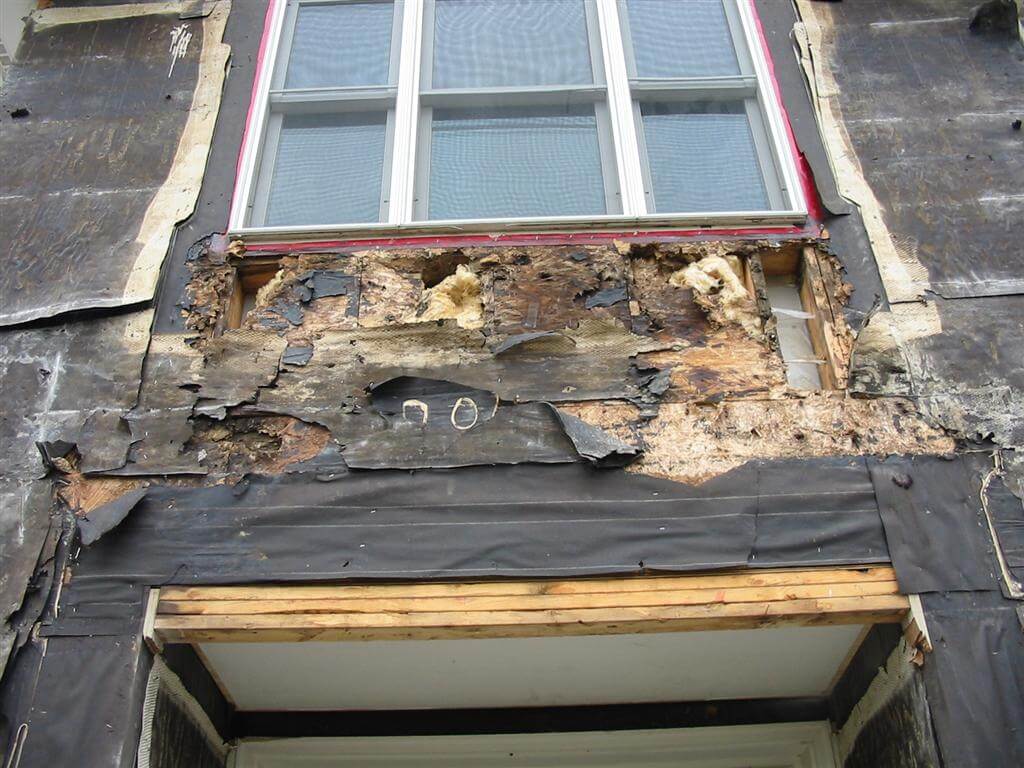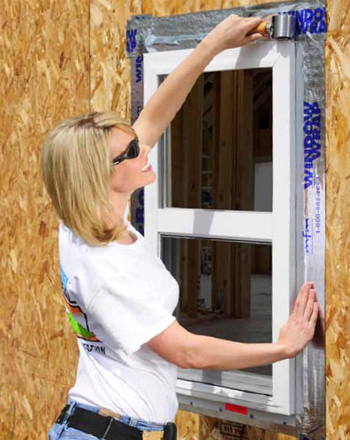How To Install Door Flashing Tape
An important part of installing new doors and windows on your home is properly sealing them. Gaps around the window or door can create drafts, which can increase your energy costs, or allow water to leak inside, causing water damage or mold growth. One material used across the top of an exterior door frame is called Z-flashing. The Z-flashing, sometimes called a drip cap, is a strip of metal that resembles the letter 'Z' when viewed in profile.
The Z-flashing seals the joint along the top of the door casing. 7Cover the top edge of the Z-flashing with building paper. In new construction, the paper should already be on the house before the doors and windows are installed. In an existing house, you may have to cut a piece for this project. If so, cut it wide enough to extend several inches on both sides of the door, and high enough to extend at least one foot above the door.
The building paper is stapled to the side of the house. Seal the joint above the casing by applying caulk and pressing the paper down upon it. Building paper is paper that is saturated with asphalt and provides protection against wind and moisture.
Windows and doors are an interruption in the wall’s house wrap or insulated sheathing drainage plane and thus are a vulnerable spot for water leakage. Many a homeowner has suffered from water intrusion around doors and windows, often not discovered until considerable damage has been done within the wall. The wall framing around windows and doors must be protected from any water that finds its way behind the siding at these locations and the water must be directed out to prevent damage to the rest of the wall. Properly installed flashing that is integrated with the other elements of the wall can help prevent water damage.Flashing materials may be installed by insulators, framers, or subcontractors or vendors hired specifically to install the windows and doors. This task should be included in the contract for the appropriate trade depending on the workflow at the specific job site.Other Considerations: When designing the home, walls and doors should be located under overhangs or porch roofs whenever possible; these features protect against rain and snow and also minimize unwanted solar heat gain by blocking out high summer sun.How to flash windows and doors. Cut the housewrap covering the rough opening in the shape of a modified 'I.' See Figure 1.
Fold the side and bottom flaps into the window opening and secure. Above the window opening, cut a head flap. Fold it up to expose the sheathing and loosely tape it in place out of the way.

Figure 2 - Install self-adhesive sill flashing in the window rough opening.For pan or sill flashing, use formable flashing, a stretchable self-adhered membrane that bends at corners so one continuous piece can be used to cover the bottom and sides of the sill. First install a back dam consisting of a strip of wood or beveled siding nailed along the back (inside) edge of the rough opening (over the flap of housewrap). Sloped pans are required if the sill depth is greater than 6 inches according to ASTM E212207.
Cover this with the membrane. Begin pressing in the middle of the sill and work toward the sides, removing adhesive covering strips as you go. Make sure to press the membrane tightly into the corners to avoid tears later when the window is installed.Other options for pan flashing include self-adhered non-elastic membrane (se Figure 3), which must be cut and patched at corners, two-piece rigid manufactured pan flashing, which comes with a built-in back dam that must be protected from breakage during window installation, or asphalt-based liquid flashing that is applied with a paint brush or roller. Figure 4 - Caulk the top and sides of the window rough opening, but not the bottom. Install jamb and head flashing. See Figure 5.

Install self-adhesive jamb flashing extending 4 inches above the top of the head flange and even with the bottom of the sill flashing. Install self-adhesive head flashing extending 1 inch beyond the jamb flashing. Unfold the housewrap and lay over the head flashing.
How To Install French Door
Tape bottom edge of housewrap across the top window flange and tape down corner seams of housewrap. See Figure 6. Water Management System Builder Requirements2. Water-Managed Wall Assembly.2.3 Window and door openings fully flashed. 11Footnote 11) Apply pan flashing over the rough sill framing, inclusive of the corners of the sill framing; side flashing that extends over pan flashing; and top flashing that extends over side flashing or equivalent details for structural masonry walls or structural concrete walls.Please see the for the program version and revision currently applicable in in your state.Exhibit 1 Mandatory Requirements.Exhibit 1, Item 1) Certified under the ENERGY STAR Qualified Homes Program or the ENERGY STAR Multifamily New Construction Program.FMA/AAMA 100-07. Standard Practice for the Installation of Windows with Flanges or Mounting Fins in Wood Frame Construction. Available from AAMA’s online store from the link above.
Window Tape Seal Flashing
The standard covers the installation of windows in new construction using a membrane/drainage system and the installation process for windows from pre- to post-installation and windows that use a mounting flange or fin attached and sealed to the window perimeter frame and designed as an installation fastening appendage. Minimum requirements for window installation based on current best practices are also provided.andASTM E-2112.

Standard Practice for Installation of Exterior Windows, Doors and Skylights. The standard covers fenestration product installation from pre-installation through post-installation procedures in new and existing construction.Section R703.8 Flashing.
Approved corrosion-resistant flashing to be applied shingle-fashion to prevent water from entering into wall cavities or from penetrating into building structural framing components. Self-adhered flashing must comply with AAMA 711. Flashing at exterior window and door openings must extend to the surface of the exterior wall finish or to the water-resistive barrier.Section R703.8 Flashing. Approved corrosion-resistant flashing to be applied shingle-fashion to prevent water from entering into wall cavities or from penetrating into building structural framing components. Self-adhered flashing must comply with AAMA 711.
Flashing at exterior window and door openings must extend to the surface of the exterior wall finish or to the water-resistive barrier. Flashing must be installed in accordance with one or more of the following:. In accordance with fenestration manufacturer’s installation and flashing instructions or in accordance with the flashing manufacturer’s instructions. Where instructions or details aren’t provided, pan flashing is to be installed at the sill of exterior window and door openings and must be sealed or sloped to direct water to the surface of the exterior wall finish or water-resistive barrier.
Openings using pan flashing must also incorporate flashing or protection at the head and sides. Per the flashing design or method of a registered design professional. Under other approved methods.andSection R703.4 Flashing. Approved corrosion-resistant flashing to be applied shingle-fashion to prevent water from entering into wall cavities or from penetrating into building structural framing components. Self-adhered flashing must comply with AAMA 711. Fluid-applied membrane flashing must comply with AAMA 714.
Flashing An Existing Exterior Door
Flashing must be installed in accordance with manufacturer’s instructions or as follows: Pan flashing at exterior window and door openings must direct water to the surface of the exterior wall finish or to the water-resistive barrier. Openings with pan flashing should also have flashing at the head and sides.Retrofit:, andSection N1101.3 (Section N1107.1.1 in 2015 and 2018 IRC).
Additions, alterations, renovations, or repairs shall conform to the provisions of this code, without requiring the unaltered portions of the existing building to comply with this code. (See code for additional requirements and exceptions.)Appendix J regulates the repair, renovation, alteration, and reconstruction of existing buildings and is intended to encourage their continued safe use. A new window was installed without repairing the failed window sill first. Image Courtesy of Building Science Corporation.Best practice when replacing windows is to remove the trim and flash the rough opening for drainage and durability per the concepts outlined in the and tabs. There are several describing measures that can be taken to improve water management, comfort, and energy efficiency with windows, ranging from repair and refurbishment to adding storm windows, to full replacement.